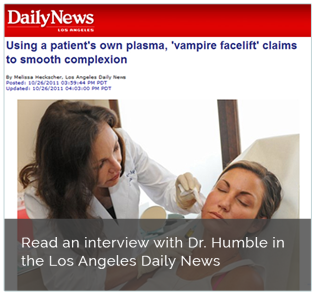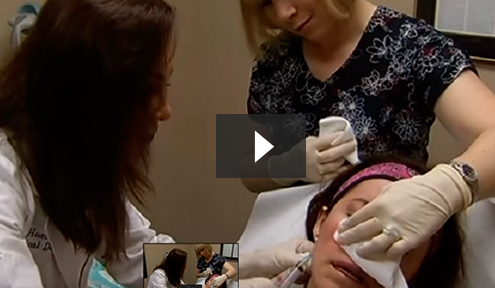Rejuvenation from Within…
Platlet rich Plasma or PRP is a treatment that involves injecting a concentrated source of platelet rich plasma obtained from patient’s own blood to into an area of concern to promote tissue healing. PRP has been used not only for cosmetic purposes but also in treating orthopedic conditions such as degenerative joint conditions, tendonitis, plastic surgery, wound healing post surgery, or burn injury to name a few.
PRP contains not only high concentrations of platelets but also seven different growth factors that stimulates tissue regeneration, collagen production and formation of new blood vessels to the treated area.
PRP treatment is a great option for:
- Improving wrinkles and lines at the surrounding eyes, mouth, forehead and neck
- Acne Scars
- Dull lifeless and sagging skin
- Hair loss treatment
- Patients looking for alternative to fillers. “The Vampire Face Lift”
- In combination with Fractional Erbium or Non Ablative laser treatment for enhanced effect
The PRP procedure involves withdrawing the patient’s own blood (~10cc) and centrifuging it to separate the red blood cells from the plasma (yellow colored blood component). The plasma obtained is then reinjected into concerned areas of the face to improve wrinkles, sagging, volume loss, and scars to achieve a rejuvenated, lifting affect. The treatment will not yield an instantaneous result, however will be appreciated over a period of time as new collagen and tissue repair occurs. Improvement can be seen as soon as one day depending on the application (for instance, if used with mesotherapy or dermarolling and applied to the deep dermis) or as long as six weeks when it is used to revolumize the face. PRP can also be combined with different laser treatments for more dramatic results.
LASERS & PRP
Fractional ablative lasers, such as the Erbium or the CO2 laser are known to be the gold standard in skin rejuvenation. Both of these lasers have shown considerable efficacy in reducing wrinkles and improving the texture and tone of the skin. These lasers are used to treat severe to mild photo damage and have been received well by the public as far as results. The problem has been that with the Co2 at least, there has been significant complications including scarring and prolonged erythema (or redness) and the down time is longer than with nonablative lasers. This is where platelet rich plasma comes in.
Fractional ablative lasers, such as the Erbium or the CO2 laser are known to be the gold standard in skin rejuvenation. Both of these lasers have shown considerable efficacy in reducing wrinkles and improving the texture and tone of the skin. These lasers are used to treat severe to mild photo damage and have been received well by the public as far as results. The problem has been that with the Co2 at least, there has been significant complications including scarring and prolonged erythema (or redness) and the down time is longer than with nonablative lasers. This is where platelet rich plasma comes in.
Platelet Rich Plasma or PRP is extracted from the patients own blood with a simple blood draw. This blood is then spun down, which separates it into red blood cells and plasma. The platelet rich plasma is simply withdrawn from the vial. When the platelets in the platelet rich plasma are activated, there is a release of several different tissue growth factors. These tissue growth factors create a new healthy blood supply, help with new tissue generation and allow this large concentration of platelets in a small volume of plasma and is known to enhance tissue healing and help skin to regenerate itself. PRP therapy has been used to heal sports stars such as Kobe Bryant and Tiger Woods.
After being treated with a fractional ablative laser, thousand of tiny microscopic wounds are spaced evenly across the skin leaving healthy untreated skin in between the laser or ablated column. These micro wounds serve two purposes. They immediately tighten the skin and stimulate collagen formation over the next 6 months and provide for a natural renewal of the skin. They also serve as small conduits to the deep dermis which allows a topically applied product to work. PRP assisted fractional resurfacing uses these micro channels to allow the PRP to get to the deep dermis and help augment and speed the recovery as well as increase the collagen synthesis. Studies have shown that PRP added to fractionated laser resurfacing significantly decrease the redness, the healing period and keeps down any post inflammatory hyper pigmentation.
The process is fairly simple: the patients own blood is drawn and centrifuged during the laser resurfacing procedure. Post laser the PRP is activated by mixing it with a calcium ion and the either sprayed or dropped over the treated skin. Because of the activation from the laser and the calcium, extremely large amounts of tissue growth factors are released which speed the regeneration of new skin. The results are better and the recovery time is markedly shortened. Together these processes can be used to achieve smoother, better texture, healthy and youthful skin in a safe rapid and reliable treatment.






